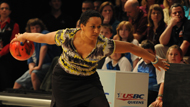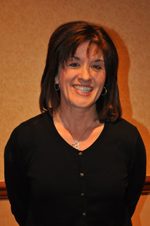Anything can happen: Bowling the USBC Queens
March 30, 2012

If you are going to become truly great at anything in your life, the thing you will do the most is fail.
The USBC Queens is a tournament where you better show up with the understanding that failure is part of the deal. It is a tournament where you watch someone on a nearby pair win a match with a 550 series while you lose with a 720, where you crush the field in qualifying only to be sent to the contender’s bracket after the opening round of match play.
 “It’s just heartbreaking,” says 2002 Queens champ, Kim Terrell-Kearney. “You can be up by 100 pins in a match, and then you shoot 180 and your opponent shoots 270 and they’re right back in it. It happens every year, and that’s why this is the greatest tournament to watch because you can’t give up and you can’t let your guard down. Anything can happen.”
“It’s just heartbreaking,” says 2002 Queens champ, Kim Terrell-Kearney. “You can be up by 100 pins in a match, and then you shoot 180 and your opponent shoots 270 and they’re right back in it. It happens every year, and that’s why this is the greatest tournament to watch because you can’t give up and you can’t let your guard down. Anything can happen.”
Those who have worn the tiara—the ones who have become truly great in this sport—will tell you this is the tournament that broke their hearts before it ever granted them their dreams.
2005 champ Tennelle Milligan will just as soon tell you about the 450 series she shot in a match for the chance to make the show as she will tell you about the day she won the tournament.
1999 champ and 2011 U.S. Women’s Open winner Leanne Hulsenberg will tell you just as much about the year she set a qualifying record only to lose in the opening round of match play as she will tell you about that win in ‘99.
Eight-time Team USA member Shannon O’Keefe will sooner recall the 10 pin she whiffed to miss the show at the 2009 Queens than she will recall the 788 she bowled in match play last year.
“So many factors come into play at the Queens that make luck a big deal,” Hulsenberg says. “Luck of the draw in match play, a good pair versus a bad pair, what kind of bowler happens to have preceded you on a given pair and how they broke down the lanes, even the way they re-oil the lanes now. If you’ve been bowling good and then you go back to bowling on the fresh, it’s a different story and your whole game plan starts over.
 “This has always been the hardest tournament to win; anyone can beat anyone else in a match.”
“This has always been the hardest tournament to win; anyone can beat anyone else in a match.”
For Tennelle Milligan, who came within just one match of clinching her second Queens title in 2010, those bitter realities Hulsenberg recounts are things unique to the Queens and its one-of-a-kind format, things you only come to terms with over time.
“In my early days bowling the Queens, I fell into that trap of watching other pairs around me and getting caught up in that, but over time you realize score doesn’t matter once you get into match play,” Milligan explains. “Any young player falls into that trap whether they admit it or not. Could you bowl really good and lose? Absolutely. Could you bowl really bad and win? Yes. But that’s what separates the champions from those who don’t make it. Being a winner is not just about winning; it’s about deciding to keep trying whether or not you win.”
As for that 450 series at the 1998 Queens, well, chalk that one up to youth and inexperience, too.
“I will never forget the moment Mo Pinel walked through the door and said ‘What did you bowl? Two games?’” Milligan jokes. “It was the first Queens I ever bowled, and I was distracted because it was my first time and I was thinking ‘Oh my gosh! I am close to the show! I have a chance! I was bowling Lynda Barnes to make the show, and I shot 450 and I go to the losers’ bracket and I am like ‘Oh my God, I just shot 450.’ That was about being a young player and not knowing what to do.
“You fail, but you get back up—you make sure you get back up—and you try again,” Milligan continues. “Because if you don’t, you will never know.”
Pressure may be a matter of age and experience for some players, but for others it is a matter of perspective, something that only exists in your mind and only is as powerful as you allow it to be.
 One such player is Shannon O’Keefe, who is widely regarded as possibly the most talented woman player in the world but still seeks her first major title.
One such player is Shannon O’Keefe, who is widely regarded as possibly the most talented woman player in the world but still seeks her first major title.
“I think pressure is something you put on yourself; it’s self-induced,” O’Keefe explains. “If it’s not meant to be, then it’s not meant to be. It really comes down to that for me. By the time I am bowling a match at the Queens, I have done everything I can up to that moment to prepare, and if that’s not good enough at that particular moment, that’s OK because someday it will be. Before, I used to think ‘Well, I work so hard, I deserve this.’ Well, no, you don’t deserve it. No one ‘deserves’ anything.”
O’Keefe is a player who has confronted every dimension of the Queens experience short of winning the title. She has averaged 251 over several rounds of match play only to find herself heading home while others prepared to bowl the show. She has made it all the way to the show only to get blasted by more than 50 pins in the first match. She has failed to convert a 10 pin to miss the show altogether.
 And just like the winners Milligan describes—the ones who keep trying no matter what—O’Keefe once again will count herself among the competitors at this year’s Queens.
And just like the winners Milligan describes—the ones who keep trying no matter what—O’Keefe once again will count herself among the competitors at this year’s Queens.
“Let’s just say I hate to lose more than I love to win,” O’Keefe says. “So losing in match play does not make me happy, but learning how to recover from that bad shot, that bad game or that bad set is really what is going to separate those who have success at the Queens from those who will not.”
Many of the players who show up to bowl the Queens this year will bring their own stories of heartbreak with them; they are the ones who already will be winners before they throw their first practice shot. They will have won the battle against what self-doubt they might have indulged back when they, too, missed that crucial 10 pin or lost the match Kim Terrell-Kearney describes as “the hardest one to lose”—the match to make the TV show.
“These days I am grateful every time I put my shoes on, because at any moment it could be taken away from me,” O’Keefe says. “And if that ever happens, I want the last moment doing what I love to have been enjoyable. And if that is losing, then at least I still was able to throw a bowling ball down the lane. It’s about finding positives in everything, and that has made the biggest difference.”
The USBC Queens is a tournament where you better show up with the understanding that failure is part of the deal. It is a tournament where you watch someone on a nearby pair win a match with a 550 series while you lose with a 720, where you crush the field in qualifying only to be sent to the contender’s bracket after the opening round of match play.
 “It’s just heartbreaking,” says 2002 Queens champ, Kim Terrell-Kearney. “You can be up by 100 pins in a match, and then you shoot 180 and your opponent shoots 270 and they’re right back in it. It happens every year, and that’s why this is the greatest tournament to watch because you can’t give up and you can’t let your guard down. Anything can happen.”
“It’s just heartbreaking,” says 2002 Queens champ, Kim Terrell-Kearney. “You can be up by 100 pins in a match, and then you shoot 180 and your opponent shoots 270 and they’re right back in it. It happens every year, and that’s why this is the greatest tournament to watch because you can’t give up and you can’t let your guard down. Anything can happen.”Those who have worn the tiara—the ones who have become truly great in this sport—will tell you this is the tournament that broke their hearts before it ever granted them their dreams.
2005 champ Tennelle Milligan will just as soon tell you about the 450 series she shot in a match for the chance to make the show as she will tell you about the day she won the tournament.
1999 champ and 2011 U.S. Women’s Open winner Leanne Hulsenberg will tell you just as much about the year she set a qualifying record only to lose in the opening round of match play as she will tell you about that win in ‘99.
Eight-time Team USA member Shannon O’Keefe will sooner recall the 10 pin she whiffed to miss the show at the 2009 Queens than she will recall the 788 she bowled in match play last year.
“So many factors come into play at the Queens that make luck a big deal,” Hulsenberg says. “Luck of the draw in match play, a good pair versus a bad pair, what kind of bowler happens to have preceded you on a given pair and how they broke down the lanes, even the way they re-oil the lanes now. If you’ve been bowling good and then you go back to bowling on the fresh, it’s a different story and your whole game plan starts over.
 “This has always been the hardest tournament to win; anyone can beat anyone else in a match.”
“This has always been the hardest tournament to win; anyone can beat anyone else in a match.”For Tennelle Milligan, who came within just one match of clinching her second Queens title in 2010, those bitter realities Hulsenberg recounts are things unique to the Queens and its one-of-a-kind format, things you only come to terms with over time.
“In my early days bowling the Queens, I fell into that trap of watching other pairs around me and getting caught up in that, but over time you realize score doesn’t matter once you get into match play,” Milligan explains. “Any young player falls into that trap whether they admit it or not. Could you bowl really good and lose? Absolutely. Could you bowl really bad and win? Yes. But that’s what separates the champions from those who don’t make it. Being a winner is not just about winning; it’s about deciding to keep trying whether or not you win.”
As for that 450 series at the 1998 Queens, well, chalk that one up to youth and inexperience, too.
“I will never forget the moment Mo Pinel walked through the door and said ‘What did you bowl? Two games?’” Milligan jokes. “It was the first Queens I ever bowled, and I was distracted because it was my first time and I was thinking ‘Oh my gosh! I am close to the show! I have a chance! I was bowling Lynda Barnes to make the show, and I shot 450 and I go to the losers’ bracket and I am like ‘Oh my God, I just shot 450.’ That was about being a young player and not knowing what to do.
“You fail, but you get back up—you make sure you get back up—and you try again,” Milligan continues. “Because if you don’t, you will never know.”
Pressure may be a matter of age and experience for some players, but for others it is a matter of perspective, something that only exists in your mind and only is as powerful as you allow it to be.
 One such player is Shannon O’Keefe, who is widely regarded as possibly the most talented woman player in the world but still seeks her first major title.
One such player is Shannon O’Keefe, who is widely regarded as possibly the most talented woman player in the world but still seeks her first major title.“I think pressure is something you put on yourself; it’s self-induced,” O’Keefe explains. “If it’s not meant to be, then it’s not meant to be. It really comes down to that for me. By the time I am bowling a match at the Queens, I have done everything I can up to that moment to prepare, and if that’s not good enough at that particular moment, that’s OK because someday it will be. Before, I used to think ‘Well, I work so hard, I deserve this.’ Well, no, you don’t deserve it. No one ‘deserves’ anything.”
O’Keefe is a player who has confronted every dimension of the Queens experience short of winning the title. She has averaged 251 over several rounds of match play only to find herself heading home while others prepared to bowl the show. She has made it all the way to the show only to get blasted by more than 50 pins in the first match. She has failed to convert a 10 pin to miss the show altogether.
 And just like the winners Milligan describes—the ones who keep trying no matter what—O’Keefe once again will count herself among the competitors at this year’s Queens.
And just like the winners Milligan describes—the ones who keep trying no matter what—O’Keefe once again will count herself among the competitors at this year’s Queens.“Let’s just say I hate to lose more than I love to win,” O’Keefe says. “So losing in match play does not make me happy, but learning how to recover from that bad shot, that bad game or that bad set is really what is going to separate those who have success at the Queens from those who will not.”
Many of the players who show up to bowl the Queens this year will bring their own stories of heartbreak with them; they are the ones who already will be winners before they throw their first practice shot. They will have won the battle against what self-doubt they might have indulged back when they, too, missed that crucial 10 pin or lost the match Kim Terrell-Kearney describes as “the hardest one to lose”—the match to make the TV show.
“These days I am grateful every time I put my shoes on, because at any moment it could be taken away from me,” O’Keefe says. “And if that ever happens, I want the last moment doing what I love to have been enjoyable. And if that is losing, then at least I still was able to throw a bowling ball down the lane. It’s about finding positives in everything, and that has made the biggest difference.”





